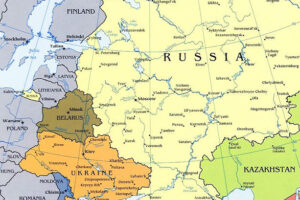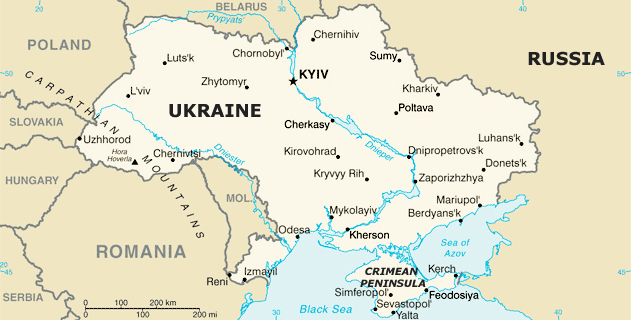Ukraine Can Kneel or Starve

(Bloomberg – bloomberg.com – Marc Champion – May 21, 2014)
Marc Champion writes editorials on international affairs. He was previously Istanbul bureau chief for the Wall Street Journal. He was also an editor at the Financial Times and the editor-in-chief of the Moscow Times. He is based in London.
Now that the prospect of a hot war in Ukraine has begun to recede ahead of Sunday’s presidential election, the struggle for control of the country is returning to a more familiar battlefield: natural gas.
Since the Soviet Union collapsed, Ukraine’s corrupt elites, unable to pick between cheap Russian gas and political independence, have tried to have both. When President Viktor Yanukovych was forced to choose last year, he went for cheap gas.
That enraged many Ukrainians, because they understood it meant institutionalized corruption and permanent vassalage to Russia, so they tossed Yanukovych out. Yet the tightly linked questions of how much independence Ukraine can have and how much it must pay for gas remain unanswered.
The coming natural gas war could turn hot as soon as June 3, should Russia’s OAO Gazprom follow through with its threat to cut off Ukraine’s gas supply — and therefore the European Union’s.
To understand how this game of pipelines will be fought, I went to see the chairman of Ukraine’s state-owned natural gas company, NAK Naftogaz. Andriy Kobolyev is just 36 years old and refreshingly open — the new face of a company that has been one of the world’s most corrupt. (How much did his predecessors steal? “Billions,” he said.)
Naftogaz faces two threats. The first is the gas-price increase Gazprom has ordered — from $268.50 during the final weeks of Yanukovych’s rule to $486.50, which it wants to charge as of June 2. The second is South Stream, a Russia-backed pipeline that would circumvent Ukraine to deliver gas directly from Russia to the European Union. The pipeline could be operational as soon as 2017, reducing Ukraine’s bargaining power and potentially wiping $20 billion from Naftogaz’s balance sheet.
Ukraine’s economy remains what it was during the Soviet era: an appendage of the Russian natural-gas industry. Naftogaz itself accounts for roughly 8 percent of Ukraine’s gross domestic product. The chemicals and metals factories in the troubled east account for almost half Ukraine’s exports and consume a similar proportion of its gas imports. If the cost of gas rises to $486.50, the chemical factories would shut. Many metals companies would switch from gas to coal, but at a cost.
Ukraine says $268.50 is the correct market price. It wants the dispute to go to arbitration in Sweden and for the old gas price to apply pending a resolution. What is its case?
With Gazprom the only supplier, there is no gas market in Ukraine. Kobolyev argues that, based on previous arbitration cases, the correct price should be calculated by looking at the geographically closest country that has a diversified gas market, in this case Germany.
Germany has recently paid an average of about $320 per thousand cubic meters for gas. Subtract the cost of transit across Ukraine ($30-$33), and from the Ukrainian border to Germany (another $40, Kobolyev estimates), and you get a price of $250 per thousand cubic meters of gas. That’s even better than Yanukovych’s “vassalage” discount.
This might be fair, but it is also a fantasy: Ukraine remains at the mercy of a monopoly supplier. So, after we spoke, Kobolyev left for Slovakia to try to persuade its gas-transit company, Eustream, to reverse the flows in some underutilized pipelines. This would give Naftogaz access to more than 30 billion cubic meters of gas that Gazprom sells to EU countries at a lower price than to Ukraine.
Unfortunately for Ukraine, a Gazprom subsidiary controls the switches in Slovakia. Gazprom also wrote the Eustream contract to ban flow reversal, precisely to isolate Ukraine’s gas market from competition. Kobolyev wants the EU to declare that contract anti-competitive and therefore illegal, but his hand is weak.
The only leverage Ukraine really has is its hold on the transit of Russian gas to the EU: If Gazprom reduces the flow to cut off Ukraine but Naftogaz keeps taking gas, supply to the EU falls.
Russia came up with South Stream to end this leverage. The pipeline is the second of a pair Russian President Vladimir Putin decided to build after previous price tussles with Ukraine. The share of Russian gas exports to the EU that flow through Ukraine declined from as much as 93 percent until 2000 to less than 50 percent largely because of Nord Stream, which loops through the Baltic Sea from Russia to Germany. If South Stream is fully built and filled, Gazprom will no longer need Ukraine for transit at all, potentially leaving its huge transit pipelines empty and worthless.
“That is the final goal of Gazprom,” says Kobolyev. “The strategy of Gazprom is to have excess transit capacity, for example double the size of their exports. By that tool they will be always able to choose any transit route” and thus pressure not only Ukraine, but new transit partners such as Bulgaria, Serbia, Hungary and Slovenia.
Kobolyev believes Russia is playing hardball in price negotiations because it wants to shut off the supply on June 3 to demonstrate to EU governments and the European Commission that building South Stream is essential to their energy security.
So Ukraine may soon have to choose between penury brought on by industries closing under the pressure of expensive gas and accepting Russia’s political demands. The only long-term solution for a truly independent Ukraine is to reform its economy and diversify its energy supplies.
Such change, however, would step on vested interests and inflame sentiment in the east, where factory workers would lose their jobs. More likely, the oligarchs who continue to dominate Ukraine are already outlining a new deal with Russia to put off the day they have to choose between cheap gas and independence, at least until South Stream is built.
Article ©2014 Bloomberg L.P. All Rights Reserved. Article also appeared at http://www.bloombergview.com/articles/2014-05-21/ukraine-can-kneel-or-starve

